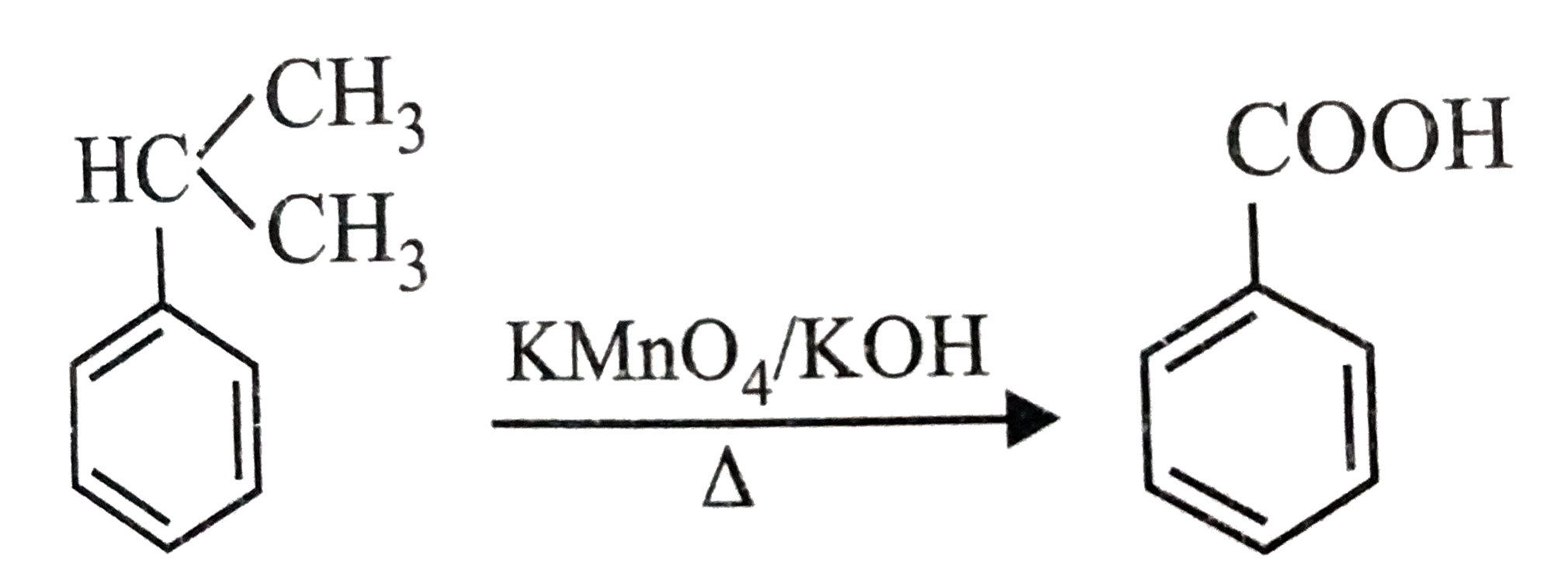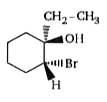Which of the following reactions does not show the correct products of the reaction?
The correct Answer is:B
To determine which of the reactions does not show the correct products, we need to analyze the reactions involving alkenes and halogen acids. The addition of halogen acids to alkenes can follow two main rules: Markovnikov's rule and anti-Markovnikov's rule.
1. Identify the Reactions:
We have several reactions where alkenes react with halogen acids (like HCl, HBr). We need to analyze each reaction to see if the products formed are consistent with the rules of addition.
2. Understand Markovnikov's Rule:
Markovnikov's rule states that when a halogen acid adds to an alkene, the hydrogen atom (H+) will attach to the carbon with more hydrogen atoms already attached, while the halide (Cl- or Br-) will attach to the carbon with fewer hydrogen atoms.
3. Understand Anti-Markovnikov's Rule:
The anti-Markovnikov addition occurs specifically with HBr in the presence of peroxides (H2O2). In this case, the bromine (Br-) will attach to the carbon with fewer hydrogen atoms, and the hydrogen (H+) will attach to the carbon with more hydrogen atoms.
4. Analyze Each Reaction:
- For each reaction option provided, determine if they follow Markovnikov's or anti-Markovnikov's rule correctly.
- If a reaction involves HBr with peroxide, it should follow the anti-Markovnikov rule.
- If a reaction involves HCl or HBr without peroxide, it should follow Markovnikov's rule.
5. Identify Incorrect Products:
- Look for any reaction where the product does not align with the expected outcome based on the rules above.
- For example, if HCl is used in the presence of peroxide, it should still follow Markovnikov's rule, as HCl does not exhibit peroxide effects.
6. Conclusion:
After analyzing all the reactions, identify the one that does not produce the correct product according to the rules. From the analysis, it was determined that option B does not show the correct product because it incorrectly applies the peroxide effect to HCl, which is not valid.
Final Answer:
The reaction that does not show the correct products is Option B.
---
We have several reactions where alkenes react with halogen acids (like HCl, HBr). We need to analyze each reaction to see if the products formed are consistent with the rules of addition.
Markovnikov's rule states that when a halogen acid adds to an alkene, the hydrogen atom (H+) will attach to the carbon with more hydrogen atoms already attached, while the halide (Cl- or Br-) will attach to the carbon with fewer hydrogen atoms.
The anti-Markovnikov addition occurs specifically with HBr in the presence of peroxides (H2O2). In this case, the bromine (Br-) will attach to the carbon with fewer hydrogen atoms, and the hydrogen (H+) will attach to the carbon with more hydrogen atoms.
- For each reaction option provided, determine if they follow Markovnikov's or anti-Markovnikov's rule correctly.
- If a reaction involves HBr with peroxide, it should follow the anti-Markovnikov rule.
- If a reaction involves HCl or HBr without peroxide, it should follow Markovnikov's rule.
- Look for any reaction where the product does not align with the expected outcome based on the rules above.
- For example, if HCl is used in the presence of peroxide, it should still follow Markovnikov's rule, as HCl does not exhibit peroxide effects.
After analyzing all the reactions, identify the one that does not produce the correct product according to the rules. From the analysis, it was determined that option B does not show the correct product because it incorrectly applies the peroxide effect to HCl, which is not valid.
The reaction that does not show the correct products is Option B.
Topper's Solved these Questions
- BOOK - NCERT FINGERTPS ENGLISHCHAPTER - HYDROCARBONS EXERCISE - Higher Order Thinkin Skills7videos
HYDROCARBONS
- BOOK - NCERT FINGERTPS ENGLISHCHAPTER - HYDROCARBONS EXERCISE - Assertion & Reason15videos
HYDROCARBONS
- BOOK - NCERT FINGERTPS ENGLISHCHAPTER - EQUILIBRIUM EXERCISE - Assertion And Reason15videos
EQUILIBRIUM
- BOOK - NCERT FINGERTPS ENGLISHCHAPTER - HYDROGEN EXERCISE - Assertion And Reason15videos
HYDROGEN
Similar Questions
Knowledge Check
- Question 1 - Select One
Which of the following reactions does not occur ?
A B
B C
C D
D
- Question 2 - Select One
Choose the correct product of this reaction :
 A
A B
B C
C D
D
- Question 3 - Select One
Which of the following reactions is not correct ?
AMnO−4+8H++5Fe2+→5Fe3++Mn2++4H2OB2MnO2+4KOH+O2→4KMnO4+2H2OC2Na2CrO4+2H+→Na2Cr2O7+2Na++H2ODK2Cr2O7+7H2SO4+6KI→4K2SO4+Cr2(SO4)3+3I2+7H2O
Which of the following reactions is correct.
View SolutionWhich of the following reactions is correct?
View SolutionWhich of the following reaction does not form ether as major product ?
View SolutionWhich of the following reactions does not show the acidic nature of ethyne?
View SolutionWhich of the following reactions are correct ?
View Solution

